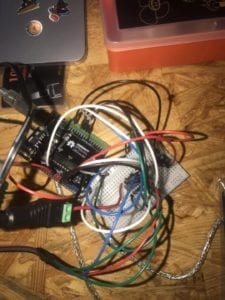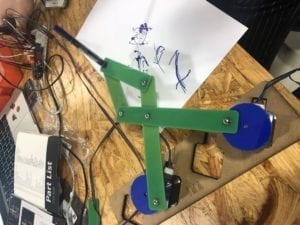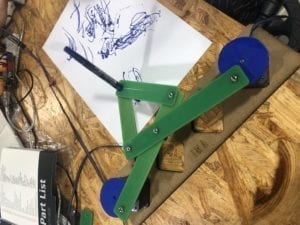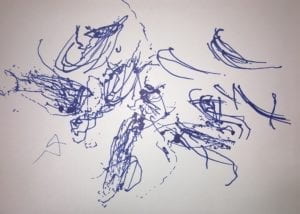Recitation Week 4
Circuit Building Process
Building this circuit was a bit of a challenge, as there were a lot more wires involved than in any of the previous ones I’ve built. I finished my first trial of building the circuit quite quickly, though the motor did not spin when I uploaded the code. I took apart the circuit and reconnected everything a second time, this time by using the negative and positive columns on the side of the breadboard (when before I had connected everything that needed power or ground straight to the Arduino). This made it easier to keep track of all my wires, as the cables weren’t all crossed over each other. When I then tried to plug in my circuit and upload the code, it worked perfectly.

Building the Drawing Machine
I partnered up with Kyle to build the drawing machine out of our two motors. This part was relatively simple as connecting all the pieces was pretty straightforward. We ran into a bit of trouble with mapping the code, as we weren’t sure of where in the code to put our ‘map’ values. However, we looked up details about the map feature on the Arduino reference website and figured out where to put it. There was an issue with uploading my code onto my Arduino and the motor after we assembled the machine, but after just unplugging and re-plugging the power source we got it to work. The motors were a bit shaky, and therefore the lines the machine drew with the marker weren’t super smooth, but we were still able to create an ‘abstract’ artwork.



Question 1
I would be interested in building a machine that is able to track and record the movement of a pen/paintbrush, and can then recreate that art piece. The machine could be connected to a pen, which someone then uses like a drawing utensil.
I’ve enjoyed incorporating actuators into the circuits we build, because they allow for an extra level of interaction between the circuit and the user. In the circuit we built today, it allowed us to control the drawing machine by physically moving parts connected to the circuit, whereas in past circuits we used only the code to manipulate the circuit. With the idea I expressed earlier, the digital manipulation of art would be utilized because technology would be able to ‘recreate’ an artwork drawn by someone, with a code created that could alter parts of the drawing (e.g. stretching or compressing certain lines and changing drawing mediums). An actuator could be used to allow the machine movement while the artist is drawing their piece, and to allow for further manipulation of a copy of the art piece which the machine can create.
Question 2
I was very intrigued by Daniel Palacios Jimenez’s Waves art installation. I thought it was cool how the motion create by the ropes created an illusion of solid waves within the installation. Similarly, I liked how the motion sensors he selected allowed for interaction between viewers and the art piece. This is similar to the work I did during the recitation because, in accordance to the machine I built, viewers can also interact with it by turning the knob corresponding to the actuator. I think the selection of the actuator for Jimenez’s project was simple, because he wanted one that spun in order for the ropes to turn and create the visual illusion.